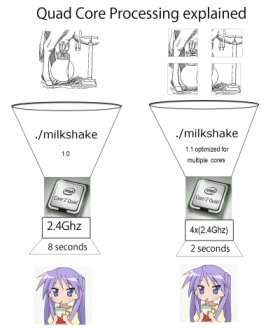Multi Core Processor

While shrinking an existing CPU's component size or cooling it better allows you to increase its Clock Speed, physics dictates that computer chips can only get so small (unless you get exotic). Adding more stages to the instruction pipeline allows for the processor to do more in less time, but excessive pipeline length makes non-linear code execute slowly. How can we continue to make processors faster now that all of our old tricks are starting to run into a brick wall, CPU makers asked themselves? Simple, pack more than one of these modern processor cores in each computer.
The multi-core processor is an effort to try to make the processor as efficient as possible by trying to get as many processes (programs) and threads (tasks within the program) done as possible. However a CPU still can only handle one process at a time (until we figure out another solution) and in many cases, only one thread at a time. But there are two huge advantages to multi-core processors aside from packing so much into so little:
- The computer can handle as many processes as there are cores.
- A process can take all the cores for maximum throughput.
The only problem is that this only boosts the performance of programs that are highly CPU-bound. That is, they spend most of their time crunching numbers. Good examples of CPU-bound programs include image and video editing programs and 3D model renders. Highly I/O bound programs idle most of the time, and thus, do not benefit from more than one CPU. These programs include word processors, internet browsers, and even the GUI of the OS. Performance benefits for games varies. Some games scale with more cores, while others won't see it.
There's also the issue of coordination. You do not want a CPU core to work on a process that another is working on. Nor do you want the cores stamping on another's memory space. This was especially a problem with the Sega Saturn and part of the reason why developers hated it. Granted, Sega's Virtua Fighter Remix (the less said about the first version, the better) did provide a good example of how to use the system, but this was a new thing at the time. Many programmers stuck with the tried and true programming for one processor. Another issue is whether or not the OS can address those cores.
A common misconception is that multi-core processors are the same as a single core with a multiplied speed. A single core with multiplied speed will always handle instructions faster than a multi-core processor can, especially with processes that can't run on more than one core. For example, if Process A, B, and C had run time completion of 1, 2, and 3 respectively, a quad-core processor will get this done in 3 seconds (each process gets a core). A single core processor of multiplied speed will get them done in (1 + 2 + 3)/4 or 1.5 seconds.
The limitations of parallelizing code are spelled out by Amdahl's Law on The Other Wiki.